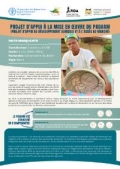This global knowledge platform provides a user-friendly gateway to practical guidance and information on the development of Sustainable Food Value Chains (SFVC). SFVC development is a market-oriented and systems-based approach for measuring, analysing and improving the performance of food value chains (FVCs) in ways that help ensure their economic, social and environmental sustainability. An extensive vocabulary of technical terms developed specifically for SFVCs allows refined searches of the platform’s comprehensive databases. Underpinning the platform is a community of members, which facilitates networking and the exchange of ideas among policy-makers, project designers, field practitioners and other people working on topics related to SFVCs.
In Benin, the national agricultural development strategy advocates for a paradigm shift focused on the creation of added value through the promotion of inclusive economic ...
This brief outlines a rigorous and standardized approach for value chain analysis and design, taking a systems perspective to analyse and influence the behaviour and ...
The development of sustainable food systems is a key component of the 2030 Agenda for Sustainable Development. This course discussed why eliminating ...
Developed jointly by the International Trade Centre and the International Labour Organization, this training will help existing and potential managers ...
Business and Management Specialists with experience and/or interest in pineapples/tropical fruits wanted!
The ASTA project in Suriname is posting two positions find managers for a pineapple innovation Hub, which will be set ...
National Expert on Apicultural Value Chains needed!
FAO is looking for a national expert on Apicultural Value Chains in Uzbekistan.
Please find the Terms of Reference below.
For further ...
Rome, Italy - The Food Systems and Food Safety Division (ESF) at the Food and Agriculture Organization (FAO) is pleased ...
November 15, 2023- FAO Technical Network on Sustainable Food Value Chains Development & Finance (SFVC D&F) has organized a webinar ...





